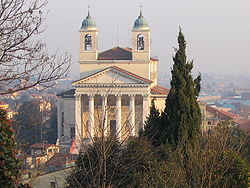
Vicenza is a city in northeastern Italy. It is in the Veneto region, at the northern base of the Monte Berico, where it straddles the River Bacchiglione. Vicenza is approximately 60 kilometres (37 mi) west of Venice and 200 kilometres (120 mi) east of Milan.

Andrea Palladio was an Italian Renaissance architect active in the Venetian Republic. Palladio, influenced by Roman and Greek architecture, primarily Vitruvius, is widely considered to be one of the most influential individuals in the history of architecture. While he designed churches and palaces, he was best known for country houses and villas. His teachings, summarized in the architectural treatise, The Four Books of Architecture, gained him wide recognition.
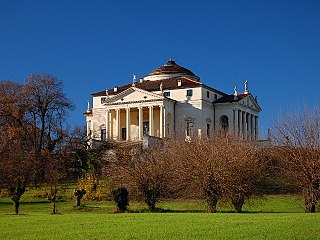
Villa La Rotonda is a Renaissance villa just outside Vicenza in Northern Italy designed by Italian Renaissance architect Andrea Palladio, and begun in 1567, though not completed until the 1590s. The villa's official name is Villa Almerico Capra Valmarana, but it is also known as "La Rotonda", "Villa Rotonda", "Villa Capra", and "Villa Almerico Capra". The name Capra derives from the Capra brothers, who completed the building after it was ceded to them in 1592. Along with other works by Palladio, the building is conserved as part of the World Heritage Site "City of Vicenza and the Palladian Villas of the Veneto".
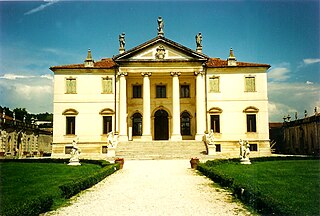
The province of Vicenza is a province in the Veneto region of Italy. Its capital city is Vicenza.
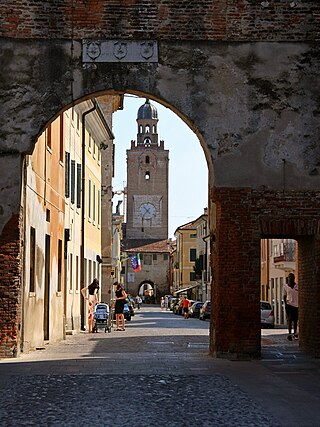
Castelfranco Veneto is a town and comune (municipality) of Veneto, northern Italy, in the province of Treviso. It is the third largest municipality in the province by population after the capital Treviso and Conegliano. It is centrally located between the cities of Treviso, Padua and Vicenza, it is a walled city with a well-preserved medieval castle.
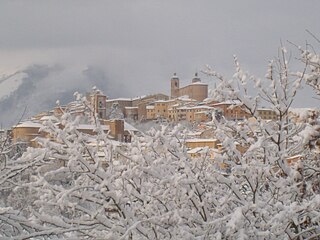
Camerino is a town in the province of Macerata, Marche, central-eastern Italy. It is located in the Apennines bordering Umbria, between the valleys of the rivers Potenza and Chienti, about 64 kilometres (40 mi) from Ancona.

Gallarate is a city and comune of Alto Milanese of Lombardy and of Milan metropolitan area, northern Italy, in the Province of Varese. It has a population of some 54,000 people.
Valdagno is a town and comune in the province of Vicenza, north-eastern Italy. The town was the birthplace of the textile manufacturing company Marzotto, and home to the Italian hotel chain "Jolly Hotels".

Asola is a comune in the province of Mantua, Lombardy. It received the honorary title of city with a presidential decree of October 23, 1951.

Pacentro is a comune of 1,279 inhabitants of the province of L'Aquila in Abruzzo, Italy. It is a well-preserved historic medieval village located in central Italy, several kilometers from the City of Sulmona about 170 kilometres (110 mi) east of Rome. It is one of I Borghi più belli d'Italia.
Isola Vicentina is a small town and comune in the Italian province of Vicenza in the Veneto region. Its population is around 9,319.
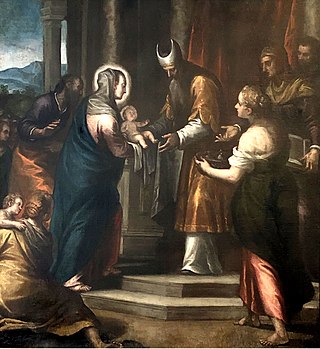
Alessandro Maganza (1556–1630) was an Italian painter of the Mannerist style, born and active in Vicenza, as well as in Venice.

Meyrueis is a commune in the Lozère department in southern France.

The history of Italian fashion is a chronological record of the events and people that impacted and evolved Italian fashion into what it is today. From the Middle Ages, Italian fashion has been popular internationally, with cities in Italy producing textiles like velvet, silk, and wool. During the Middle Ages and Renaissance, Italian fashion for both men and women was extravagant and expensive, but the fashion industry declined during the industrialization of Italy. Many modern Italian fashion brands were founded in the late 19th and early 20th centuries, and in the 1950s and 1960s, Italian fashion regained popularity worldwide. While many clients of Italian fashion designers are celebrities, Italian fashion brands also focus on ready-to-wear clothes.

Nicolò Tron was an Italian politician, businessman and agronomist, citizen of the Republic of Venice.

The Jewel of Vicenza was a silver model of the city of Vicenza made as an ex-voto in the 16th century and attributed to the architect Andrea Palladio. The Jewel was stolen by the Napoleonic army during the Italian Campaign in the French Revolutionary Wars and subsequently destroyed. A copy was created between 2012 and 2013.

San Pietro, or St Peter, is the Neoclassical-style, main Roman Catholic church or duomo of the town of Schio, region of Veneto, Italy.
Santa Maria del Summano is a pilgrimage church associated with Monte Summano in the province of Vicenza, region of Veneto, Italy. The church is referred to by various names: Santuario della Beata Vergine dell'Angelo di Piovene or Santuario Santa Maria del Summano.

Alessandro Rossi was an Italian textile industrialist and politician. He introduced technological innovation for manufacturing wool in Schio, Veneto. He inherited the wool mill Lanificio Rossi from his father Francesco Rossi, and converted the company into one of the main industries of Italy. He was deputy and senator of the Kingdom of Italy.
Lanerossi is an Italian textile brand, established in the 19th century by Schio's Lanificio Rossi. Since 1987, the brand belongs to the Italian group Marzotto, which use it for the design, production, and marketing of textiles.
